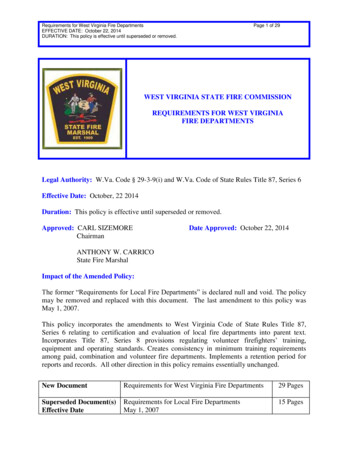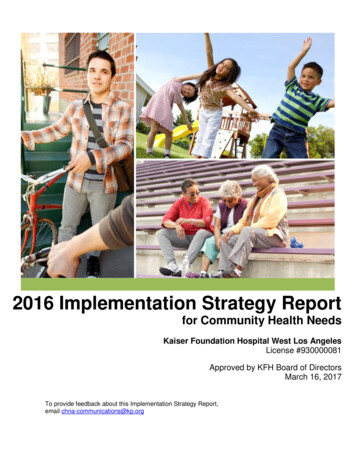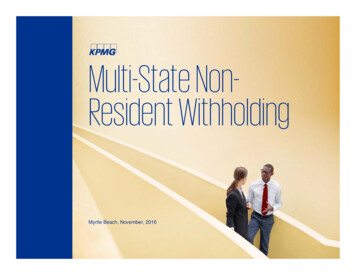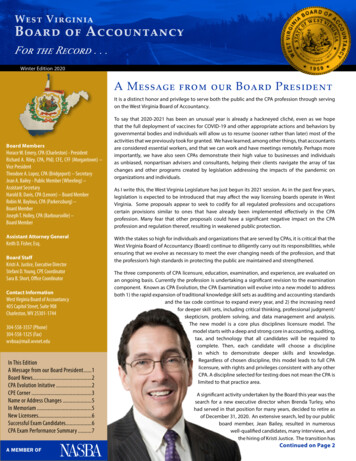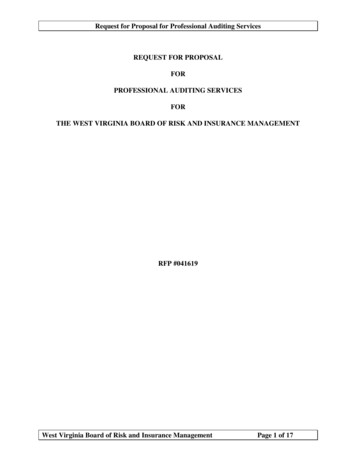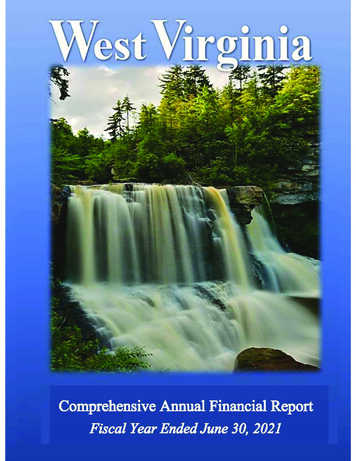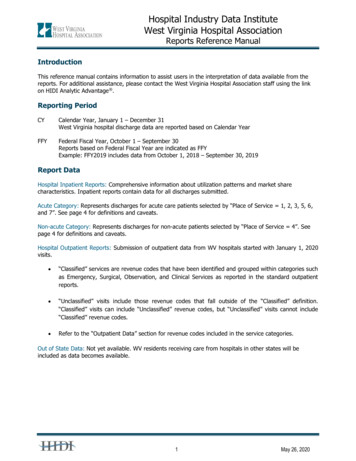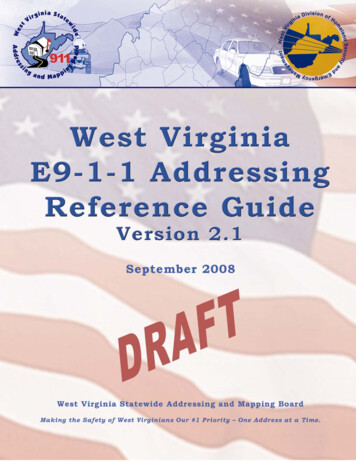
Transcription
West Virginia E9-1-1 AddressingReference GuideVersion 2.1September 2008This report was prepared by Michael Baker Jr., Inc. forThe West Virginia Statewide Addressing and Mapping Board.Please forward any comments, recommendations, concerns or requests for anupdated version of this document to:West Virginia Statewide Addressing and Mapping BoardThe Greenbrooke Building1124 Smith Street, Room LM-10Charleston, WV 25301West Virginia Statewide Addressing and Mapping BoardMaking the Safety of West Virginians Our #1 Priority – One Address at a Time. Copyright 2008West Virginia Statewide Addressing and Mapping Board, All Rights Reserved
EXECUTIVE SUMMARYThe State Legislature created the West Virginia Statewide Addressing andMapping Board (WVSAMB or the Board) in 2001 to enable city-type addressingin rural areas of the state for E9-1-1 service. A city-type address, such as 250Mountain Road, clearly identifies where a telephone is physically located whendialing 9-1-1.Current rural postal addresses do not provide this locationinformation.The WVSAMB is providing long-needed assistance to counties, and wherenecessary, to municipalities, for the creation of city-type addresses where nonecurrently exist. The WVSAMB will continue to work with county and municipalofficials to achieve the Legislature’s goal of establishing city-type addresses for theprompt and accurate dispatch of emergency services.By creating theseaddresses, county officials will ensure that their citizens receive the full benefit ofE9-1-1 service by having emergency response agencies know precisely where helpis needed. Lives and property of citizens in your community will be saved.For those counties and municipalities with existing city-type addresses, theWVSAMB is providing assistance to help review those addresses to ensure theymeet the West Virginia E9-1-1 Addressing Standards.This review will helpidentify existing city-type addresses that are confusing to emergency dispatchersand responders and provide a method for change.However, the WVSAMBrespects the past accomplishments of counties and municipalities that alreadyhave city-type addresses. Current city-type addresses should not change unless itis necessary or advisable for the prompt and accurate dispatch of emergencyservices to protect human life and property or the maintenance of generalcommunity security.In addition, any proposed address change should besubmitted to the proper county or municipal authorities for approval.To encourage all counties and municipalities to participate in this effort, theWVSAMB is providing this final, revised reference guide, a standard addressing
WEST VIRGINIA E9-1-1 ADDRESSING REFERENCE GUIDE – VERSION 1.1WVSAMBprocess, training, and continued support for the statewide addressing project.The WV 9-1-1 Addressing Handbook, First Edition was released in April 2003 andprovided detailed information on how local governments should start their E9-1-1addressing process and the critical role that they must play in the E9-1-1addressing and database development process. The WVSAMB released a secondedition handbook, the WV 9-1-1 Addressing Handbook, Volume II in October2004, which provided the necessary tasks for completing the addressing process.This West Virginia E9-1-1 Addressing Reference Guide combines thevaluable and relevant tasks and standards from the first two handbooks, and is toserve as the final guide for the statewide addressing project.Tasks from thehandbooks, which are now obsolete, have been updated accordingly. Please referto this final and completed reference guide for direction on the addressing project.The WVSAMB invites all counties and municipalities to participate in thisstatewide E9-1-1 addressing project, support for which is only available for alimited time. By participating, county and municipal officials will ensure that allcitizens of West Virginia receive the full benefit of E9-1-1 service. The lives andproperty of your fellow citizens may well depend on your decision to participate inthis important iseGeospatialInformation System designed to meet the very mission-specific addressing andmapping needs of the state.This system will provide county addressingcoordinators with Web-based, easy-to-use tools necessary to perform -reporting,advancedimport/export tools, and matching capabilities. The system will also serve wasthe long-term maintenance solution, and is to be maintained and housed by theWest Virginia Department of Military Affairs and Public Safety’s, Division ofHomeland Security and Emergency Management Addressing Coordination Office(WVDSHEM-ACO) and the Governor’s Office of Technology (WVGOT), respectively.iiJANUARY 2007
WVSAMBWEST VIRGINIA E9-1-1 ADDRESSING REFERENCE GUIDE – VERSION 1.1TABLE OF CONTENTS1.0INTRODUCTION TO THE E9-1-1 ADDRESSING REFERENCE GUIDE ANDNOTES ON PREVIOUS HANDBOOKS. 12.0WEST VIRGINIA STATEWIDE ADDRESSING AND MAPPING BOARD . 33.0WVSAMB MEMBERS . 54.0OVERVIEW OF WEST VIRGINIA E9-1-1 ADDRESSING PROCESS. 74.15.0The West Virginia E9-1-1 Addressing Process General Steps . 84.1.1Preparatory Tasks . 94.1.2Completion Tasks . 10ROLES AND RESPONSIBILITIES . 125.1West Virginia Statewide Addresing and Mapping Board . 125.1.1WVSAMB Project Manager . 135.1.2WVSAMB Mapping Contractor . 135.1.3WVSAMB Addressing Contractor. 145.2Role of the West Virginia Department of Military Affairs and PublicSafety, Division of Homeland Security and Emergency Management(WVDHSEM) . 155.3Role of the US Postal Service . 165.4Role of Verizon and Independent Telephone Companies . 186.0TASKS TO PREPARE FOR THE E9-1-1 ADDRESSING PROCESS. 196.1Provide a written commitment to the WVSAMB by July 1, 2003 . 196.2Appoint an Addressing Coordinator. 206.3Identify all roads in the county emergency road network. . 216.4Adopt E9-1-1 addressing standards. . 226.5Enact an addressing ordinance. . 246.6Notify residents of the E9-1-1 addressing process . 266.7Apply for WVSAMB PARTIAL reimbursement funds . 276.8Review and/or update current tax database mailing addresses (for areaswithout city-type addresses). 276.9Review existing city-type addresses to identify problems (for areas withcity-type addresses) . 286.10 Contact adjacent counties and municipalities within your county. . 30JANUARY 2007iii
WEST VIRGINIA E9-1-1 ADDRESSING REFERENCE GUIDE – VERSION 1.1WVSAMB6.11 Review road names for duplicate or similar-sounding names. 326.12 Identify staff to work with the WVSAMB and its contractors. 337.0TASKS FOR COMPLETING THE E9-1-1 ADDRESSING PROCESS . 367.1Complete road centerline and site mapping. 367.2Finalize all Road names . 377.3Delineate Emergency Service Zone boundaries. 377.4Assign or Review City-type Addresses . 387.5Perform field Validation and Collection . 407.6Complete Field Edits, if necessary. 427.6.1Map Plots . 427.6.2Informational Meetings with Cooperating Agencies. 437.7Perform Old-to-New Address Matching. 447.8Perform Telephone number (TN) matching . 447.8.17.9Local call centers . 45Create USPS Address Conversion Package and prepare addressnotifications. 467.10 Create Telephone conversion files . 477.11 Perform address conflation (for areas with city-type addresses) . 487.12 Create or update Master Street Address Guide. 487.13 Continue Address and database maintenance. 48APPENDIX A BASIC E9-1-1 GLOSSARY. 52APPENDIX B WVSAMB LEGISLATIVE RULES . 54APPENDIX C WEST VIRGINIA E9-1-1 ADDRESSING STANDARDS. 82APPENDIX C1 ROAD NAMING STANDARDS . 84APPENDIX C2 PROPERTY NUMBERING STANDARDS. 87APPENDIX C3 NUMBER POSTING STANDARDS . 93APPENDIX C4 ROAD NAME SUFFIXES FOR NEW ROADS. 94APPENDIX C4 (CONT.) SUFFIX ABBREVIATIONS FOR EXISTING ROADS . 95APPENDIX C5 ROAD SIGNAGE . 96APPENDIX D OFFICIAL PARTICIPATION LETTER. 99APPENDIX E MODEL COUNTY ADDRESSING ORDINANCE . 100APPENDIX F MODEL MUNICIPAL ADDRESSING ORDINANCE. 114ivJANUARY 2007
WVSAMBWEST VIRGINIA E9-1-1 ADDRESSING REFERENCE GUIDE – VERSION 1.1APPENDIX G US POSTAL SERVICE LETTER OF CONFIDENTIALITY . 120APPENDIX H INFORMATION LETTER TO RESIDENTS. 121APPENDIX I CONTACT INFORMATION . 122APPENDIX J FREQUENTLY ASKED QUESTIONS. 123APPENDIX K SAMPLE MAP PLOT. 132APPENDIX L SAMPLE CONFIDENTIALITY AGREEMENT . 133APPENDIX M SAMPLE INFORMATION MEETING LETTER . 136APPENDIX N SAMPLE CALL CENTER SCRIPT . 137APPENDIX O SAMPLE ADDRESS NOTIFICATION LETTER . 138NOTES . 139JANUARY 2007v
WEST VIRGINIA E9-1-1 ADDRESSING REFERENCE GUIDE – VERSION 1.1WVSAMBTHIS PAGE INTENTIONALLY LEFT BLANK.viJANUARY 2007
1.0 INTRODUCTION TO THE E9-1-1 ADDRESSING REFERENCEGUIDE AND NOTES ON PREVIOUS HANDBOOKSThe West Virginia Statewide Addressing and Mapping Board (WVSAMBor Board) developed the West Virginia 9-1-1 Addressing Handbook, FirstEdition, which was released in April 2003.This edition described the tasksthat counties and municipalities needed to accomplish to prepare themselvesfor the addressing project.The First Edition contained the followinginformation: An overview of the West Virginia Statewide Mapping and AddressingProject. A set of Frequently Asked Questions (FAQs) about the project. An overview of the roles and responsibilities in the project. An overview of the WVSAMB and its project manager and contractors. A detailed list of tasks for participating counties and municipalities tocomplete prior to working with the WVSAMB Addressing Contractor. An appendix that includes:o A basic glossary of E9-1-1 termso WV E9-1-1 Addressing Standards for road naming, propertynumbering, number posting, and road signage.o Model addressing ordinances for counties and municipalities.o Sample letters for requesting USPS data and for notifying residentsabout the project.The West Virginia 9-1-1 Addressing Handbook, Volume II was developedto provide information to counties and municipalities for completing thestatewide E9-1-1 addressing project begun in 2002. This Volume II, releasedin October 2004, built upon the tasks outlined in the First Edition by providing
WEST VIRGINIA E9-1-1 ADDRESSING REFERENCE GUIDE – VERSION 1.1WVSAMBdetailed information on those tasks that remain to be accomplished by localgovernments.The West Virginia 9-1-1 Addressing Handbook, Volume II contained thefollowing information: Described the tasks to be undertaken by counties and municipalities tocomplete E9-1-1 address assignment and E9-1-1 database development. Described how counties and municipalities will work with the WVSAMBand its contractors, using the mapping, addressing, and database toolsand other provided materials. Updated resources, such as the Permanent Rules adopted by the Boardand enacted by the West Virginia Legislature in April 2004. Discussed short-term and long-term maintenance of E9-1-1 mappingdata and addressing databases.This West Virginia E9-1-1 Addressing Reference Guide combines thevaluable and relevant tasks and standards from the first two handbooks,and is to serve as the final guide for the statewide addressing project.Tasks from the handbooks, which are now obsolete, have been updatedaccordingly. Please refer to this final and completed reference guide fordirection on the addressing project.For additional copies of the West Virginia E9-1-1 Addressing 58-5300orwww.addressingwv.org.2JANUARY 2007
WVSAMBWEST VIRGINIA E9-1-1 ADDRESSING REFERENCE GUIDE – VERSION 1.12.0 WEST VIRGINIA STATEWIDE ADDRESSING AND MAPPINGBOARDThe West Virginia Statewide Addressing and Mapping Board was establishedby passage of Senate Bill 460 in 2001.Under this bill, the mission of theWVSAMB is to provide city-type addresses for the large rural areas of the state toinsure that these areas are accorded access to the same level of prompt andaccurate emergency service as urban areas. At the same time, the previous effortsof those counties and municipalities that had made progress in achieving city-typeaddressing are to be respected. In its efforts, the WVSAMB is employing the icinformationsystemstechnologies to complete this ambitious project.Since 2002, the WVSAMB has accomplished the following tasks infulfillment of its statutory mission: Hired a project manager to assist the Board with the design of the overalladdressing and mapping process, the development of addressing andmapping standards, and the monitoring of the mapping and addressingcontractors. Hired a mapping contractor to create the mapping layers necessary tosupport addressing, a task that was completed in August 2004. Published and distributed over 1500 copies of the West Virginia inia9-1-1Addressing Handbook, Volume II in 2003 and 2004 to county andmunicipal officials and others. Hired an addressing contractor in late 2003 to create new city-styleaddresses for addressable structures that lacked them. Developed and implemented the West Virginia Statewide Addressing andMapping System (WVSAMS) for the long term maintenance and sustainmentof the WVSAMB and County E9-1-1 databases.JANUARY 20073
WEST VIRGINIA E9-1-1 ADDRESSING REFERENCE GUIDE – VERSION 1.1WVSAMBThe WVSAMB is composed of eleven members appointed by the governor,representing the Public Service Commission, State Geological and EconomicSurvey, Department of Military Affairs and Public Safety, Division of Highways,county commissioners, county assessors, municipalities, directors of E9-1-1systems from counties with a population of thirty thousand or less, directors ofE9-1-1 systems from counties with a population of greater than thirty thousand,local exchange telephone companies, and the public at large. WVSAMB membersand their contact information are available in Section 3.0.The WVSAMB holds regular meetings that are open to the public, and publicparticipation and input on its activities are welcomed.abouttheWVSAMBanditsactivities,pleaseFor more informationvisititswebsiteatwww.addressingwv.org or call 304-558-5300.4JANUARY 2007
WVSAMBWEST VIRGINIA E9-1-1 ADDRESSING REFERENCE GUIDE – VERSION 1.13.0 WVSAMB MEMBERSJimmy Gianato (Chairman)DirectorWV Division of Homeland Securityand Emergency ManagementEmail: Jimmy.J.Gianato@wv.govHussein Elkhansa (Vice Chairman)GIS Section HeadWV Department of HighwaysEmail: Hussein.S.Elkhansa@wv.govJim PriesterMarion County AssessorEmail: jpriester@assessor.state.wv.usDave TarbettCitizen Member, Mason CountyAssessor’s OfficeEmail: dtarbett@assessor.state.wv.usCounsel to the WVSAMB:Michael A. Albert, ChairmanWV Public Service CommissionEmail: malbert@psc.state.wv.usJoseph J. StarsickSpecial Assistant Attorney GeneralGoodwin and Goodwin, LLPEmail: joseph.j.starsick@verizon.comJack D. Bowden, DirectorRaleigh County E9-1-1Email: raleigh911@charter.netStaff to the WVSAMB:Kathy BuckleyVerizon CommunicationsEmail: kathy.l.buckley@verizon.comFran KingClay County CommissionEmail: franking@frontiernet.netKatherine KapoWV State GIS CoordinatorEmail: kkapo@gis.state.wv.usRon Kyle, Retired DirectorMECCA 9-1-1Email: tpsbrsk@verizon.netDean Meadows, DirectorWyoming County 9-1-1Email: mdmeadows@verizon.netLeigh A. CielenskyExecutive Assistant to theState GIS Coordinator and WVSAMBEmail: leighc@gis.state.wv.usJerry Bennett, SupervisorTelecommunications & Cable TVWV Public Service CommissionEmail: jlbennett@psc.state.wv.usEmeritus MembersRobert Anthony, Retired ManagerDepartment of HighwaysClinton (Bud) Beaver, ExecutiveDirectorPutnam AgingJames H. Caruthers, FormerPutnam County CommissionerCathy Collins-Frye, Retired DirectorUpshur County 9-1-1JANUARY 20075
WEST VIRGINIA E9-1-1 ADDRESSING REFERENCE GUIDE – VERSION 1.1WVSAMBEmeritus Members (cont.)Craig NeidigWV Geospatial LiaisonUS Geological SurveyFred Smart, Retired DirectorHarrison County 9-1-1Dannie Walker, Former SupervisorPublic Service CommissionMartha Walker, FormerCommissionerPublic Service CommissionDonald (Tom) WilliamsFormer Enhanced 9-1-1 ServiceManagerVerizon Communications6JANUARY 2007
WEST VIRGINIA E9-1-1 ADDRESSING REFERENCE GUIDE – VERSION 1.1WVSAMB4.0 OVERVIEW OF WEST VIRGINIA E9-1-1 ADDRESSINGPROCESSEnhanced 9-1-1 service (E9-1-1) is an improved emergency communicationsystem that automatically displays the address of a caller at an emergency callanswering center. If a caller is hysterical, becomes unconscious, or is forced tohang up, the answering center will know where to send help. This is also true ifthe caller does not speak English or is unfamiliar with his or her location, such asan out-of-state visitor, or even a resident, such as a babysitter.To provide the location of a caller, a telephone number must be linked to acity-type address that clearly identifies the location of that telephone. While thestatutory authority to create addresses lies with counties and municipalities, theWVSAMB is providing assistance to support local addressing efforts.Thisassistance consists of this reference guide, standards, training, and extensivesupport provided by the WVSAMB.The primary goal of E9-1-1 addressing is to link each telephone number to acity-type address that clearly identifies where a telephone is physically located.For the purposes of this project a “city-type address” means a unique address fora structure using a building number and street name. City-type addresses arebased on an address system, which means that they usually appear in aconsistent numeric sequence along a street and reflect parity conventions (that is,odd numbers all appear on one side of the street and even numbers on the other).If number assignment is based on a standard numbering interval, then the “citytype address” will also logically provide a distance location from the beginningpoint of the road.E9-1-1 addressing requires the creation of a city-type address for anyproperty that currently has a telephone, might have one installed, or might beoccupied by someone using a cellular phone. Ideally, there should be one addressper property that can be used for all purposes, ex. E9-1-1 service, mail delivery,commercial delivery services (UPS, FedEx, etc.), and utility companies.Havingmore than one address can potentially confuse a building's occupants when7JANUARY 2007
WEST VIRGINIA E9-1-1 ADDRESSING REFERENCE GUIDE – VERSION 1.1WVSAMBconfirming a location in an emergency. It might also confuse those responding tothe emergency.Residents with rural delivery mailing addresses (RR or HC boxes), in mostcases, will be able to use their new E9-1-1 addresses for mail delivery by the USPostal Service. Residents who use a Post Office box for mail delivery will continueto do so and will also have a city-type address for E9-1-1 service and emergencyresponse.Some of the benefits of implementing E9-1-1 addresses include: A property number and road name will be displayed on a computerscreen at a call answering center when dialing E9-1-1 in anemergency, thus providing the greatest benefit from Enhanced 9-1-1service. Because an E9-1-1 address identifies the physical location of a calleron a road, law enforcement, fire, and emergency medical servicepersonnel are able to locate the caller much easier and quicker in anemergency, saving precious time and often lives. When an E9-1-1 address is used as a mailing address, the US PostalService will no longer have to change rural route mailing addresseswhen adjusting carrier routes. Utility company personnel will be able to better locate a structure incase of trouble. Home and business owners will receive quicker and more reliabledeliveries by UPS, FedEx, and other delivery services, because thoseservices require a street address for deliveries.4.1THE WEST VIRGINIA E9-1-1 ADDRESSING PROCESS GENERAL STEPSThe general steps in the West Virginia E9-1-1 addressing process are listedbelow. Tasks to be completed by local governments are divided into two phases,preparatory tasks and completion tasks. Preparatory tasks are steps for countiesor municipalities to begin the E9-1-1 addressing process.8These tasks willJANUARY 2007
WVSAMBWEST VIRGINIA E9-1-1 ADDRESSING REFERENCE GUIDE – VERSION 1.1prepare the county or municipality for working with the WVSAMB. Completiontasks are those steps necessary to complete the addressing project. The WVSAMBwill assist counties and municipalities as they undertake and accomplish thesteps for completing the E9-1-1 addressing and database development process.4.1.1 Preparatory TasksPreparatory tasks are those that were discussed in the West Virginia 9-1-1Addressing Handbook, First Edition. These steps defined tasks that participatingcounties and municipalities need to accomplish to start the process of creatingE9-1-1 addresses. Tasks counties and municipalities should complete to preparefor the addressing project:1.Provide a written commitment for project participation to the WVSAMB byDecember 2003.2.Appoint an Addressing Coordinator to work with the WVSAMB.3.Identify and name all roads in the county emergency road network.Eliminate conflicting road names.4.Adopt E9-1-1 addressing standards.5.Enact an addressing ordinance incorporating addressing standards anddetailing the process.6.Notify residents of the E9-1-1 addressing process.7.Apply for WVSAMB Partial Reimbursement Funds8.For counties or communities without city-type addresses:-9.Review and/or update current tax database mailing addresses.For counties or communities with existing city-type addresses:-Review existing city-type addresses to evaluate how well they meet theWest Virginia E9-1-1 Addressing Standards adopted by the WVSAMB.10. Contact adjacent counties or the county’s municipalities to discuss thenaming and numbering of shared roads.11. Review road names and approve changes, to the extent possible.12. Identify staff to work with WVSAMB.JANUARY 20079
WEST VIRGINIA E9-1-1 ADDRESSING REFERENCE GUIDE – VERSION 1.1WVSAMBThe above activities will be discussed in further detail in Section 6.0.4.1.2 Completion TasksThe WVSAMB will assist counties and municipalities as they undertake andaccomplish the steps for completing the E9-1-1 addressing and databasedevelopment process.This assistance includes support for completing thosepreparatory tasks yet to be accomplished, guidance on addressing issues, andtools for assigning and confirming road names, reviewing assigned propertyaddresses and Master Street Address Guides, identifying Emergency ServiceZones, completing address conversions with the US Postal Service and telephonecompanies, and beginning address and mapping maintenance.The remaining steps for local governments to accomplish include:1.Complete road centerline and site mapping.2.Finalize names for all roads to eliminate conflicts or similar soundingnames.3.Delineate Emergency Service Zone boundaries, in conjunction withneighboring jurisdictions.4.Assign city-type addresses to all addressable structures, or review city-typeaddresses in already-addressed areas.5.Perform field collection (where needed).6.Complete field edits, if necessary.7.Perform old-to-new address matching for each site.8.Perform telephone number (TN) matching for each site.9.Create rural address conversion packages for the US Postal Service, whererural mail delivery exists. Prepare address notification letters for citizens.10. List updates to local telephone company databases that assign city-typeaddresses to all telephones.11. For areas with city-type addresses, conflate original address informationonto WVSAMB mapping.10JANUARY 2007
WVSAMBWEST VIRGINIA E9-1-1 ADDRESSING REFERENCE GUIDE – VERSION 1.112. Create or update final Master Street Address Guides (MSAGs).13. Maintain addressing and mapping data upon completion of all addressingactivities.The above activities will be discussed in further detail in Section ytakeapproximately two to three years of consistent local government effort, at whichtime maintenance activities will begin. During this time, local governments willneed to commit staff time to complete all the required tasks, which will necessitatethe allocation of existing, and possibly temporary, resources.The WVSAMBaddressing support does require local governments to comply with WVSAMB rulesand standards and to complete the tasks identified by the WVSAMB for thisstatewide mapping and addressing project.Counties and municipalities are under no obligation to request addressingassistance from the WVSAMB. If they accept this support, however, they will beexpected to carefully follow and complete the steps outlined in this referenceguide. A county or municipality that chooses to hire a private contractor for itsaddressing efforts should require that the contractor follow the identified steps toinsure compatibility with statewide E9-1-1 addressing standards, E9-1-1 databaserequirements, US Postal Service address conversion requirements, WVSAMB dataspecifications, and all written agreements with the WVSAMB. Please consult theWest Virginia Statewide Addressing and Mapping System Data Specification forfurther details regarding data specifications requirements.Some West Virginia counties and municipalities have used contractors toperform all or part of the work needed to develop new addresses.These localgovernments should review their established addressing systems and addresses toevaluate how well they meet the West Virginia E9-1-1 Addressing Standardsadopted by the WVSAMB and found in this reference guide under Appendix C. Inaddition, they will be asked to provide a list of the names and intersection addressranges for all street and roads in their jurisdictions.JANUARY 200711
WEST VIRGINIA E9-1-1 ADDRESSING REFERENCE GUIDE – VERSION 1.15.0WVSAMBROLES AND RESPONSIBILITIESThe following pages provide specific information regarding the roles andresponsibilities of various entities in the West Virginia E9-1-1 addressing process.Sections 6.0 and 7.0 detail the responsibilities of the Counties and Municipalities(if applicable), including those with, and those without, City-Type Addresses. Inthis section, information is provided for the following entities: West Virginia Statewide Addressing and Mapping Board (WVSAMB) WVSAMB Contractors West Virginia Department of Military Affairs and Public Safety, Division ofHomeland Security and Emergency Management (WVDHSEM) US Postal Service Verizon and Independent Telephone Companies5.1WEST VIRGINIA STATEWIDE ADDRESING AND MAPPING BOARDThe West Virginia Statewide Addressing and Mapping Board (WVSAMB) wascreated by state statute to provide city-type addressing for the large rural areas ofthe state. This project will ensure that these areas are accorded access to thesame level of prompt and accurate dispatch of emergency services as urban areas.The WVSAMB is employing the latest digital mapping, global positioning, andgeographic information system technologies to complete this ambitious project.The specific responsibilities of the WVSAMB are to: Adhere to Chapter 24E, Article 1 of the W.Va. Code. Develop the statewide addressing and mapping system. Establish addressing rules, standards, and an addressing process. Provide an addressing handbook or reference guide with modelordinances. 12Hire a pro
WEST VIRGINIA E9-1-1 ADDRESSING REFERENCE GUIDE - VERSION 1.1 WVSAMB process, training, and continued support for the statewide addressing project. The WV 9-1-1 Addressing Handbook, First Edition was released in April 2003 and provided detailed information on how local governments should start their E9-1-1


